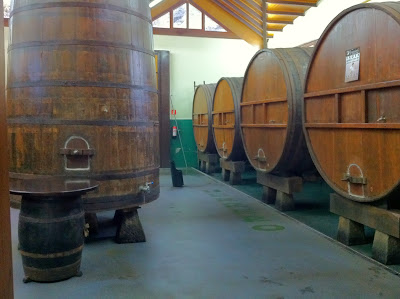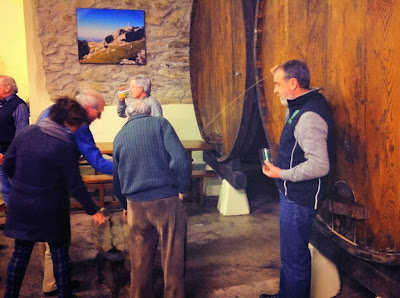Txotx Season in the Basque Country
Each fall, Basque cider makers start filling enormous wooden vessels full of fresh apple juice. As in England and France, traditional cider making is all-natural: the apples are ground and pressed, and nature takes its course. The difference, of course, is that the cider that begins pouring out of these vessels in January is sharp and acidic.
One of the reasons I delayed my cider tour until the year's bitterest month was to enjoy the start of Basque cider season, which began a couple weeks ago. It's called txotx (the tx combo, common in the language, is pronounced "ch," so txotx is something like choach), but the season includes far more than just fresh cider. Txotx is a ritual.
The heart of cider country is Gipuzkoa, the bastion of Basque culture and language. (The Basques are spread across seven states in two countries in the lush hillsides of far Northeast Spain and the French Pays Basque that includes Biarritz.) Donostia is the population center--the Spanish name, San Sbastian, is often defaced on street signs--but the capital of cider is ten minutes south in Astigarraga. It's a town of 5,000, but the hills are covered with apple trees, supplying perhaps a dozen or more local cideries (it depends on where you draw the line). In the small area of Gipuzkoa, there are over fifty.
The first place we visited was Sarasola, where I got an initial taste of txotx. But that was lunchtime. We got the full experience last night at Isastegi, a few miles further south. During the months of txotx season, all the cideries open their doors and serve a massive four or five course meal. You eat right in the barrel room, and periodically someone will holler out "txotx!"--the call to the barrels, or kupelas in Basque. Although anyone can sample from the kupelas at any time, txotx is real a community celebration and the best way to do it is together. One by one people hold out their glasses as a small font of cider arcs out. Basques believe the best way to drink cider is by "breaking" it; that is, allowing gravity to send it crashing into the side of the glass, momentarily aerating it. You only collect two fingers in your glass. The aromas rise, and you drink it while there's still a froth on the surface. Any left over you dump down the drain. (This apparent apostasy is actually good sense; "txotx" will ring out all night and the prudent pace themselves.)
The menu for txotx season has been fixed since the 1960s. Before that, when this region was almost completely rural, the locals would bring their own food. Now, they come only with an appetite. The first course is an omelette made with cod and rustic bread. Traditionally, there weren't even chairs--people stood around tables. But at some places, like Isastegi, they still don't use plates. It's family style--you just grab a crust of bread and your fork and dive in. The next course is cod, either prepared in a famous sauce called pil-pil or served with green pepper and garlic. The main course is a huge hunk of beefsteak barbecued bloody rare. Finally, dessert is cheese and walnuts with an apple or quince paste. In some cases, it seems like the feast begins with a sausage course--because, presumably, the other four might otherwise leave you feeling peckish.
Cider is meant to accompany food. In every restaurant we visited, it was always available, and about 60% of the time people chose it over local Rioja wine. Basque cuisine is hearty and salty. To my palate, it's the salt that harmonizes with the sharp Basque cider. Salt somewha neutralizes the acidity, and more subtle fruit and tannin notes emerge. Not everyone agrees it's the salt, though--at Isastegi they believe it's the "protein" (umami?) that draws out cider's flavors.
Whatever it is, the Basque food definetly serves cider well. I would go <i>almost</i> so far as saying you need to salty food to fully appreciate Basque cider. Probably not, but I would certainly encourage the pairing just in case.
If you do find yourself in what the Basques call Euskadi (Basque Country) between mid-January and Easter, txotx is a must-see event. Sarasola sees 20,000 people come through their doors for it, and more-remote Isastegi 6,000. Attendees are mostly locals (many of whom go back and back), and it feels like you're witnessing a very particular bit of Basque culture. It's not really a tourist event, though tourists are welcomed with broad smiles. Don't expect to hear anything but the rat-a-tat fire of Basque (certainly no English), but it hardly matters. The menu is set and there's really only one word that matters. You'll hear it with increasing frequency throughout the night.



